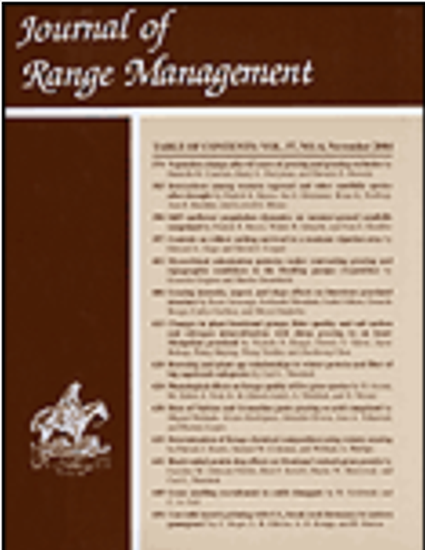
Article
Grass seedling recruitment in cattle dungpats
Journal of Rnage Management
(2004)
Abstract
Livestock seed dispersal (fecal seeding) is gaining recognition as a method to reintroduce desirable species to degraded rangelands. A field study was conducted to determine the influence of cattle dungpat thickness on the recruitment of Sandberg bluegrass (Poa secunda Presl.), bluebunch wheatgrass (Psuedoroegneria spicata [Pursh] A. Love), and 'Hycrest' crested wheatgrass (Agropyron desertorum [Fisch. ex Link] Schutt. x A. cristatum [L] Gaert.) in naturally and artificially deposited dungpats. Four Holstein heifers each were fed 60 000 seeds of each species. Twenty-four hours after feeding seeds, dung was collected from 2 animals receiving each plant species and formed into uniform, artificial dungpats (2 kg in mass) with thicknesses of 1, 2, and 4 cm, and respective diameters of 40, 28, and 20 cm, and deposited on bare soil. The other 2 animals receiving each plant species were used to deposit natural dungpats, varying in mass, thickness, and diameter, on bare soil. Seedling recruitment in all dungpat types was greatest for crested wheatgrass, followed by Sandberg bluegrass and bluebunch wheatgrass. Recruitment for all species was generally greatest in 1-cm-thick artificial dungpats, followed in order by 2-cm-thick artificial dungpats, natural dungpats, and 4-cm-thick artificial dungpats. Most seedlings, regardless of species, emerged and survived in the interior region of 1- and 2-cm-thick artificial dungpats and at the periphery of 4-cm-thick artificial dungpats...
Keywords
- fecal seeding; revegetation; seed dispersal; seedling emergence; seedling establishment
Disciplines
Publication Date
November, 2004
DOI
DOI: 10.2307/4004023
Citation Information
Christopher A. Call. "Grass seedling recruitment in cattle dungpats" Journal of Rnage Management Vol. 57 Iss. 6 (2004) p. 649 - 655 Available at: http://works.bepress.com/christopher_call/11/
